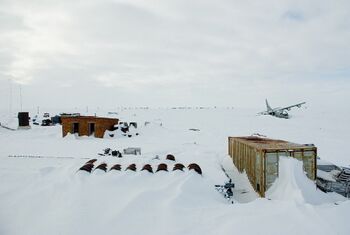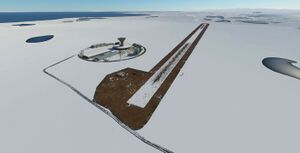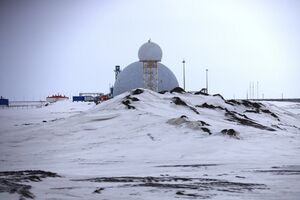Otdalennyy Island
| Native name: Отдаленный Исланд | |
|---|---|
 Remains of Mishkino Air Base. Some of the former air bases facilities were in use by the Licanan administered Containment Enforcement Base - Otdalennyy Island but have since been abandoned. | |
| Geography | |
| Location | Northern Thetian Ocean |
| Area | 1,557 km2 (601 sq mi) |
| Highest elevation | 509 m (1,670 ft) |
| Highest point | Bol'shoy Kolokol'chik |
| Administration | |
| Demographics | |
| Population | 5,340 (2020) |
Otdalennyy Island is an island in the northern Thetian Ocean. The island was formerly the territory of the Order of Soviet Socialist Republics prior to the end of the Omandan Continental War in 1994. Since then, it has been under the control of the Repubic of Licana and has hosted military forces from both Licana and several Allied nations. Currently, there is a minimal civilian population on the island, all of whom are concentrated at the Licanan administered Containment Enforcement Base - Otdalennyy Island, most of whom serve as contractors to service the facility and the units stationed there, or are family members of military personnel stationed on the island. The islands total population was estilmated to be approximately 5,340 persons in 2020.
The islands only civilian settlement, Tiksi, was depopulated during the battle, the 316 inhabitants either evacuated from the island by the Soviet Order, killed during the battle, or repatriated after the island was occupied by Licana and the Allies.
History
The settlement of Tiksi was established in 1721 as a whaling outpost by the Kingdom of Adoyeva. Initially, the settlement had a population of 59, but crew as large as 711 persons in 1755. However, with the decline of whaling income, worsened by a series of illnesses suffered by the settlers, including trichinosis brought about form consuming improperly cooked polar bear meant, killed over 200 settlers between 1760 and 1783. Tiksi was abandoned in 1790.
Several tribes of Shiye natives emigrated to the island between 1821 and 1900 in an attempt to return to their rural way of lives and escape the expanding industrialization of northern Omand. The tribesmen used the tundra as pasture for reindeer herds.
In 1914, a polar station was established near the former village of Tiksi and port facilities wee erected to maintain an icebreaker and house a crew of seven people to man the station. The establishment of the Otdalennyy Polar Station (Otdalennyy Polyarnaya Stantsiya) was the first time the island area had been inhabited by non-Shiye peoples since the departure of the settlers from Tiksi in 1790. The Shiye tribesmen living on the island had made use of the former village, but only during the summer when the reindeer were taken to pasture, with the exception of a few individuals who would over-winter in order to hunt.
Following the rise of communism and the establishment of the Soviet Order in 1897, the native herds were collectivised in 1933. Such collectivisation was very successful on the island and in 1950, the collective was turned into a formal Kolkhoz that would eventually have around 22,000 reindeer under its control. In addition to reindeer herding, the new collective was also engaged in sea-hunting and the collection of furs. Eventually, the the natives moved the village site closer to the polar station to facilitate trade between themselves, the crew of the polar station, and to make their wares available to the vessels making port. By 1944, the settlement, which had become the center of the collective farm established by the Soviet Order, had become increasingly permanent and there were 243 people living in 47 houses.
In 1951, the Soviet Order Air Force established Mishkino Air Base on the northwestern portion of the island. The air bases single runway was an unsurfaced strip 2,100 meter (6,900 ft) in length and was able to accommodate any aircraft in the Soviet Order inventory at the time, but was usable only in the 8 months of the year with sufficiently frozen ground and was generally serviceable from the end of November to the beginning of March. In 1971, a second runway was added, constructed of concrete and built to a length of 3,500 meters (11,500 feet). Its international callsign was SXOI, the X indicating it was a closed facility to commercial aviation traffic. Originally, the airbase was home to a single squadron of Soviet long-range aviation aircraft. However, as hostilities increased during the Omand Continental War, additional forces were stationed on the island and the base was expanded to accommodate more than a wing of combat aircraft in addition to support units. Prior to its invasion by the Allies in 1994, the island was home to over 10,000 Soviet military personnel.
In 1977, the Soviet Order forced the evacuation of the Shiye tribesmen living on the island, and relocated both them and their reindeer herds back to the mainland.
The island was the location of the final battle of the Omandan Continental War, in which approximately 10,000 soldiers and sailors of the Soviet Order attempted to resist an allied invasion force following the 1993 strategic nuclear exchange between the Order of Soviet Soloist Republics and the Republic of Licana.
Although the initial Licanan base on the island utilized portions of the former Mishkino Air Base, including its runway, a new facility was constructed between 1999 and 2007 featuring a concrete surfaced runway to allow for year-around operations at the base. The main facility is comprised of an 11,500 feet runway connected by road to a central area, which includes the bases power generation station and garages to service carious vehicles and aircraft. The majority of the base is subterranean, and includes facilities to service the bases garrison and population, such as recreation, housing and commissary facilities in addition to those that are military in nature. In addition to the central base, several subsidiary sites exist, including radar instillations. As of 2015, the majority of the facilities of the former Mishkino Air Base have been abandoned.
Geography
Flora and fauna
The island is home to several animal species, including reindeer and polar bears.
Climate
| Climate data for Otdalennyy Island | |||||||||||||
|---|---|---|---|---|---|---|---|---|---|---|---|---|---|
| Month | Jan | Feb | Mar | Apr | May | Jun | Jul | Aug | Sep | Oct | Nov | Dec | Year |
| Daily mean °C (°F) | −19.3 (−2.7) |
−19.5 (−3.1) |
−15.6 (3.9) |
−11.9 (10.6) |
−8.9 (16.0) |
−0.3 (31.5) |
2.5 (36.5) |
2.2 (36.0) |
−0.8 (30.6) |
−11.5 (11.3) |
−23.4 (−10.1) |
−28.7 (−19.7) |
−15.1 (4.8) |
| Average precipitation mm (inches) | 8.8 (0.35) |
6.9 (0.27) |
6.4 (0.25) |
6.5 (0.26) |
14.3 (0.56) |
17.1 (0.67) |
24.6 (0.97) |
24.8 (0.98) |
19.9 (0.78) |
17.5 (0.69) |
12.6 (0.50) |
8.9 (0.35) |
168.3 (6.63) |
| Average precipitation days (≥ 1.0 mm) | 2.0 | 1.6 | 1.5 | 2.2 | 3.0 | 4.1 | 5.2 | 5.8 | 6.4 | 5.6 | 3.5 | 1.8 | 42.7 |
| Mean monthly sunshine hours | 12 | 25 | 175 | 277 | 197 | 207 | 214 | 120 | 56 | 26 | 16 | 14 | 1,297 |

